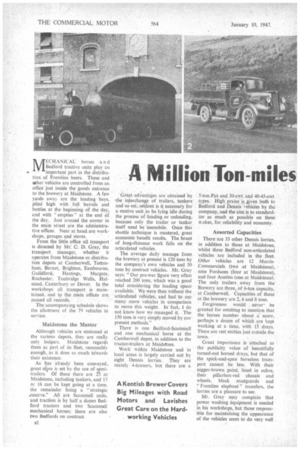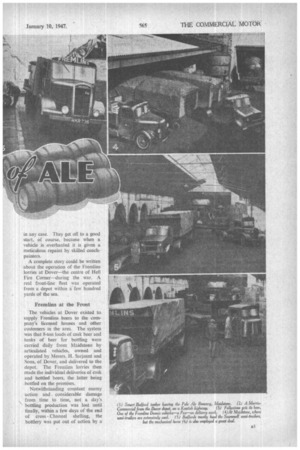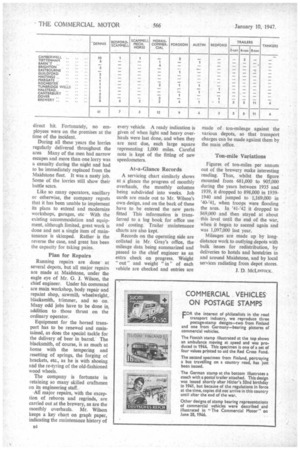A Million Ton-miles
Page 36

Page 37

Page 38

If you've noticed an error in this article please click here to report it so we can fix it.
MECHANICAL horses a n d Bedford tractive units play an important part in the distribution of Fremlins beers. These and
her vehicles are controlled from an office just inside the goods entrance to the brewery at Maidstone. A few yards away are the loading bays, piled high with full barrels and bottles at the beginning of the day, and with " empties " at the end of the day. Just around the corner in the main street are the adMinistrative offices. Near at hand. are workshops, garages and stores.
From the little office all transport is directed by Mr. C. D. Gray, the transport manager, whether it operates from Maidstone or distribution depots at Camberwell, Tottenham. Barnet, Brighton, Eastbourne, Guildford, Hastings, Margate, Rochester. Tunbridge Wells, Halstead, Canterbury or Dover. In the workshops all transport is maintained, and to the main offices are passed all records:
The accompanying schedule shows the allotment of the 79 vehicles in service.
Maidstone the Master Although vehicles are stationed at the various depots, they are really only lodgers. Maidstone regards them as part of its fleet, reasonably enough, as it does so much to-wards their existence.
As has already been conveyed, great dire is set by the use of semitrailers Of these there are 23 at Maidstone, including tankers, and 15 or 16 can be kept going at a time. the remainder being a " strategic .reserve." All are Scammell units, and traction is by half a dozen Bedford tractors and two Scammell mechanical horses; there are also two Bedfords on contract.
Great advantages are obtained by ,the interchange of trailers, tankers and so The average daily tonnage from the brewery at present is 120 tons by the company's own vehicles and 30 tons by contract vehicles. Mr. Gray says:" Our pre-war figure very often reached 200 tons, which was a good total considering the loading space available.' We were then without the articulated vehicles, and had to use many more vehicles in comparison to move this weight. In fact,. I do not know how we managed it. The 150 tons is very simply moved by our present methods." There is one Bedford-Scammell and one mechanical horse at the Camberwell depot, in addition to the tractor-trailers at Maidstone. Work within Maidstone and in local areas is largely carried out by eight Dennis lorries. They are mainly 4-tonners, but there are a 5-ton-Pax and 30-cwt. and 40-45-cwt. types. High praise is given both to Bedford and Dennis rehicles by the company, and the aim is to standardize as much as possible on these n-_akes, for reliability and economy. Assorted Capacities There are 33 other Dennis lorries, in addition to those at Maidstone, whilst three Bedford non-articulated vehicles are included in the fleet. Other vehicles are 12 MorrisCommercials (two at Maidstone), nine Fordsons (four at Maidstone), and four Austins (one at Maidstone). The only trailers away from the Brewery are three, of 6-ton capacity, at Camberwell. Capacities of those at the brewery are 2, 6 and 8 tons. Forgiveness would never be granted for omitting to mention that the horses number about a" score, perhaps a dozen of which are kept working at a time, with 15 drays. There arc rest stables just outside the town. Great importance is attached to the publicity value of beautifully turned-out horsed drays, but that of the spick-and-span horseless transport cannot be less. With their nigger-brown paint, lined in ochre, their pillarbox-red chassis and wheels, black mudguards and " Frernlins elephant" transfers, the lorries are a pleasure to see. Mr. Gray may complain that power washing equipment is needed in his workshops, but those responsible for maintaining the appearance of the vehicles seem to do very well in any case. They get off to a good start, of course, because when a vehicle is overhauled it is given a meticulous repaint by skilled coachpainters. A complete story could be written about the operation of the Fremlins lorries at Dover—the centre of Hell Fire Corner—during the war. A real front-line fleet was operated from a depot within a few hundred yards of the sea. Fremlins at the Front The vehicles at Dover existed to supply Fremlins beers to the company's licensed houses and other customers in the area. The system was that 8-ton loads of cask beer and tanks of beer for bottling were carried daily from Maidstone by articulated vehicles, owned and operated by Messrs. H. Sarjeant and Sons, of Dover, and delivered to the depot. The Fremlins lorries then made the individual deliveries of cask and bottled beers, the latter being • bottled on the premises. Notwithstanding constant enemy action and , considerable damage from time to time, not a day's bottling production was lost until finally, within a few days of the end of cross Channel shelling, the bottlery was put out of action by a direct hit. Fortunately, no employees were on the premises at the time of the incident. During all these years the lorries regularly delivered throughout the area Many of the men had narrow escapes and more than one lorry was a casualty during the night and had to be immediately replaced from the Maidstone fleet. It was a nasty job. Some of the lorries still show their battle scars. Like so many operators, ancillary or otherwise, the company regrets that it has been unable to implement its plans to extend and modernize workshops, garages, etc With the existing accommodation and equipment, although limited, great work is done and not a single item of maintenance is skimped. Rather is the reverse the case, and great has been the capacity for taking pains. Plan for Repairs Running repairs are done at several depots, but all major repairs are made at Maidstone, under the eagle eye of Mr. G. J. Wilson, the chief engineer. Under his command are main workshop, body repair and repaint shop, sawmill; wheelwright, blacksmith, trimmer, and so on. Many odd jobs have to be done in, addition to those thrust on the ordinary operator. Equipment for the horsed transport has to be renewed and maintained, as does the special tackle for the delivery of beer in barrel. The blacksmith, of course, is as much at home with the tempering and resetting of springs, the forging of brackets, etc., as he is with shoeing and the re-tyring of the old-fashioned wood wheels. The company is fortunate in retaining so many skilled craftsmen on its engineering staff. All major repairs, with the exception of rebores and regrinds, are carried out at the brewery, as are the monthly overhauls. Mr. Wilson keeps a key chart on graph paper, indicating the maintenance history of every vehicle. A ready indication is given of when light and heavy overhauls were last done, and when they are next due, each large square representing 1,000 miles. Careful note is kept of the fitting of new speedometers. At-a-Glance Records A servicing chart similarly shows at a glance the progress of monthly overhauls, the monthly columns being subdivided into weeks. Job cards are made out to Mr. Wilson's own design, and on the back of these have to be entered the new parts fitted This information is transferred to a log book for office use and costing. Trailer maintenance charts are also kept. Records on the operating side are collated in Mr. Gray's office, the mileage data being summarized and passed to the chief engineer as an extra check on progress. Weight " out " and weight "in' of each vehicle are checked and entries are made of ton-mileage against the various depots, so that transport charges can be made against them by the main office. Ton-mile Variations Figures of ton-miles per annum out of the brewery make interesting reading. Thus, whilst the figure mounted from 681,000 to 905,000 during the years between 1935 and 1939, it dropped to 898,000 in 19391940 and jumped to 1,169,000 in '40-'41, when troops were flooding the area. In '41-'42 it dropped to 869,000 and then stayed at about this level until the end of the war, when it began to ascend again and was 1,097,000 last year. Mileages are made up by longdistance work to outlying depots with bulk issues for redistribution, by deliveries to hotels and hostelries in and around Maidstone, and by local services radiating from depot stores. J. D. McLmrrocK.




















































































